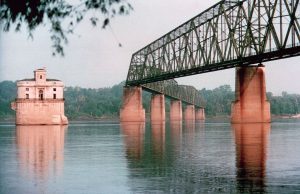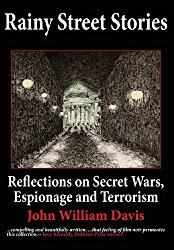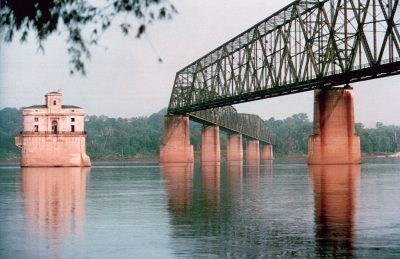
Finding the Golden Fleece
Article written by John Davis
I’ve been asked how I got interested in mystery and treasures. I know exactly, since this happened to me when I was very young and impressionable. In fact, I was about six.
My family drove over the Mississippi River on the Chain of Rocks Bridge one day in the late 1950s. We were in a dark green 1952 Ford which in those days had nothing at all like seat belts. You just bounced around on bench seats in the back, or laid in the flat area behind the headrests and squashed yourself against the back window. From this perch you waved at cars behind you.
The bridge connects an undeveloped area slightly north of St. Louis to an island in Illinois which once held the 1880s era waterworks. Nothing is there to this day, and even then it had all gone back to nature. The Chain of Rocks Bridge that went over the Mississippi spanned a parallel natural chain of rocks. The rocks form a cross channel rapids, which impeded river traffic. To avoid this natural blockage, a canal was built around them. The bridge was another story.
The Chain of Rocks Bridge literally bends about 22 degrees near the Illinois side. I learned years later that this was due to better moorings, not necessarily directly opposite one another, at either end. So we drove over this span to a little park somewhat north of where the bridge entered Illinois. It is a very memorable park, although hardly even marked in those days. It commemorates the place where it is believed Lewis and Clark set off for their mighty exploration of the newly acquired Louisiana Purchase in 1804. They were to ascend the huge Missouri River, which you can see as it enters the Mississippi across from this little park.
All I remember of the park was how green it was. We sat at one of two picnic tables. The view is still with me today, of a gigantic body of water that approaches from the northwest and poured into the even more mammoth Mississippi. As kids do, I scrambled around the debris, rocks, and driftwood piles which gathered along every inch of the bank. It was there, amid the watery river leavings, that I found a gun.
This gun was, as dad pointed out, very old. It was a handful of rust, and the handle had long since disappeared. Of course, we wondered what this could be. Dad said he thought it might be from Ft. Belle Fontaine. Today I know that was unlikely, since the Mississippi is almost mile wide where we were, and Ft. Belle Fontaine, from the Spanish era, was on the southern side of the Missouri across from where we were. Dad wondered if Lewis and Clark lost it. I remember asking which one did.
As a kid I held it like I’d just found the Golden Fleece, and only reluctantly let mom see it, but not hold it. Drawing on all my memory banks, I believe it was a pistol, maybe a revolver, but I could be wrong.
So happy was I that I clutched it the rest of the day as if it would walk away. It was mine and I found it! After our picnic, we got back into the car. And we drove over the river. My sister asked me if she could look at it. Ok. I figured after all, we were in the car and she couldn’t lose it. I gave it to her.
The car windows were wide open in those pre-air conditioned days. My sister held it, looked at it, then dropped it out the window. Over the edge of the bridge the gun bounced, and whirled into the Mississippi below.
So I always look for things, no matter where I am. Over the years I’ve found a host of remarkable treasures in the most unlikely places. But I never found the gun again. It will be found, one day when the Mississippi bends again, creating another horseshoe lake. Some other kid will find it, and know he’s found the Holy Grail.
~Written by MW Team Writer: John Davis
 John William Davis is a retired US Army counterintelligence officer and linguist. As a linguist, Mr. Davis learned five languages, the better to serve in his counterintelligence jobs during some 14 years overseas. He served in West Germany, Italy, and the Netherlands during the Cold War. There he was active in investigations directed against the Communist espionage services of the Soviet Union and Warsaw Pact. His mission was also to investigate terrorists such as the Red Army Faction in Germany, the Red Brigades in Italy, and the Combatant Communist Cells (in Belgium) among a host of others.
John William Davis is a retired US Army counterintelligence officer and linguist. As a linguist, Mr. Davis learned five languages, the better to serve in his counterintelligence jobs during some 14 years overseas. He served in West Germany, Italy, and the Netherlands during the Cold War. There he was active in investigations directed against the Communist espionage services of the Soviet Union and Warsaw Pact. His mission was also to investigate terrorists such as the Red Army Faction in Germany, the Red Brigades in Italy, and the Combatant Communist Cells (in Belgium) among a host of others.
His work during the Cold War and the bitter aftermath led him to write Rainy Street Stories, ‘Reflections on Secret Wars, Terrorism, and Espionage’. He wanted to talk about not only the events themselves, but also the moral and human aspects of the secret world as well.
Click to Read John’s Complete Profile


Sisters! lol. A great story! Thanks for sharing John. I wonder if the gun has ever been found again……
Thanks for the great story John. At the age of six I can see why you continued to search for things throughout your life. Keep penning your stories my friend…. love them…. p.s – those darn sisters are always causing problems…. lol have a great day… until next time… see ya
I’m kind of surprised your sister didn’t accidently bounce on the bridge and into the Mississippi too 🙂 Great story!
Great story!